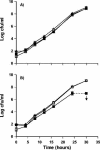Bias in the Listeria monocytogenes enrichment procedure: lineage 2 strains outcompete lineage 1 strains in University of Vermont selective enrichments
- PMID: 15691954
- PMCID: PMC546678
- DOI: 10.1128/AEM.71.2.961-967.2005
Bias in the Listeria monocytogenes enrichment procedure: lineage 2 strains outcompete lineage 1 strains in University of Vermont selective enrichments
Abstract
Listeria monocytogenes can be isolated from a range of food products and may cause food-borne outbreaks or sporadic cases of listeriosis. L. monocytogenes is divided into three genetic lineages and 13 serotypes. Strains of three serotypes (1/2a, 1/2b, and 4b) are associated with most human cases of listeriosis. Of these, strains of serotypes 1/2b and 4b belong to lineage 1, whereas strains of serotype 1/2a and many other strains isolated from foods belong to lineage 2. L. monocytogenes is isolated from foods by selective enrichment procedures and from patients by nonselective methods. The aim of the present study was to investigate if the selective enrichment procedure results in a true representation of the subtypes of L. monocytogenes present in a sample. Eight L. monocytogenes strains (four lineage 1 strains and four lineage 2 strains) and one Listeria innocua strain grew with identical growth rates in the nonselective medium brain heart infusion (BHI), but differed in their growth rate in the selective medium University of Vermont medium I (UVM I). When coinoculated in UVM I, some strains completely outgrew other strains. This outcome was dependent on the lineage of L. monocytogenes rather than the individual growth rate of the strains. When inoculated at identical cell densities in UVM I, L. innocua outcompeted L. monocytogenes lineage 1 strains but not lineage 2 strains. In addition, lineage 2 L. monocytogenes strains outcompeted lineage 1 L. monocytogenes strains in all combinations tested, indicating a bias in strains selected by the enrichment procedures. Bias also occurred when coinoculating two lineage 2 or lineage 1 strains; however, it did not appear to correlate with origin (clinical versus food). Identical coinoculation experiments in BHI suggested that the selective compounds in UVM I and II influenced this bias. The results of the present study demonstrate that the selective procedures used for isolation of L. monocytogenes may not allow a true representation of the types present in foods. Our results could have a significant impact on epidemiological studies, as lineage 1 strains, which are often isolated from clinical cases of listeriosis, may be suppressed during enrichment by other L. monocytogenes lineages present in a food sample.
Figures

Similar articles
-
Listeria monocytogenes lineages: Genomics, evolution, ecology, and phenotypic characteristics.Int J Med Microbiol. 2011 Feb;301(2):79-96. doi: 10.1016/j.ijmm.2010.05.002. Epub 2010 Aug 13. Int J Med Microbiol. 2011. PMID: 20708964 Review.
-
Competitive fitness of Listeria monocytogenes serotype 1/2a and 4b strains in mixed cultures with and without food in the U.S. Food and Drug Administration enrichment protocol.Appl Environ Microbiol. 2006 Jan;72(1):776-83. doi: 10.1128/AEM.72.1.776-783.2006. Appl Environ Microbiol. 2006. PMID: 16391118 Free PMC article.
-
Growth differences and competition between Listeria monocytogenes strains determine their predominance on ham slices and lead to bias during selective enrichment with the ISO protocol.Int J Food Microbiol. 2016 Oct 17;235:60-70. doi: 10.1016/j.ijfoodmicro.2016.07.016. Epub 2016 Jul 12. Int J Food Microbiol. 2016. PMID: 27434679
-
Identification of high-risk Listeria monocytogenes serotypes in lineage I (serotype 1/2a, 1/2c, 3a and 3c) using multiplex PCR.J Appl Microbiol. 2015 Sep;119(3):845-52. doi: 10.1111/jam.12876. Epub 2015 Aug 4. J Appl Microbiol. 2015. PMID: 26095922
-
Listeria monocytogenes serotype 1/2b and 4b isolates from human clinical cases and foods show differences in tolerance to refrigeration and salt stress.J Food Prot. 2014 Sep;77(9):1519-26. doi: 10.4315/0362-028X.JFP-13-548. J Food Prot. 2014. PMID: 25198843
Cited by
-
Prevalence and Clonal Diversity of over 1,200 Listeria monocytogenes Isolates Collected from Public Access Waters near Produce Production Areas on the Central California Coast during 2011 to 2016.Appl Environ Microbiol. 2022 Apr 26;88(8):e0035722. doi: 10.1128/aem.00357-22. Epub 2022 Apr 4. Appl Environ Microbiol. 2022. PMID: 35377164 Free PMC article.
-
Prevalence of shiga toxin producing Escherichia coli, Salmonella enterica, and Listeria monocytogenes at public access watershed sites in a California Central Coast agricultural region.Front Cell Infect Microbiol. 2014 Mar 4;4:30. doi: 10.3389/fcimb.2014.00030. eCollection 2014. Front Cell Infect Microbiol. 2014. PMID: 24624367 Free PMC article.
-
Assessing the genome level diversity of Listeria monocytogenes from contaminated ice cream and environmental samples linked to a listeriosis outbreak in the United States.PLoS One. 2017 Feb 6;12(2):e0171389. doi: 10.1371/journal.pone.0171389. eCollection 2017. PLoS One. 2017. PMID: 28166293 Free PMC article.
-
Comparison of the Prevalences and Diversities of Listeria Species and Listeria monocytogenes in an Urban and a Rural Agricultural Watershed.Appl Environ Microbiol. 2015 Jun;81(11):3812-22. doi: 10.1128/AEM.00416-15. Epub 2015 Mar 27. Appl Environ Microbiol. 2015. PMID: 25819965 Free PMC article.
-
The Persistence of Bacterial Pathogens in Surface Water and Its Impact on Global Food Safety.Pathogens. 2021 Oct 27;10(11):1391. doi: 10.3390/pathogens10111391. Pathogens. 2021. PMID: 34832547 Free PMC article. Review.
References
-
- Buchanan, R. L., and L. K. Bagi. 1997. Microbial competition: Effect of culture conditions on the suppression of Listeria monocytogenes Scott A by Carnobacterium piscicola. J. Food Prot. 60:254-261. - PubMed
-
- Buncic, S., S. M. Avery, J. Rocourt, and M. Dimitrijevic. 2001. Can food-related environmental factors induce different behaviour in two key serovars, 4b and 1/2a, of Listeria monocytogenes? Int. J. Food Microbiol. 65:201-212. - PubMed
-
- Capita, R., C. Alonso-Calleja, M. Prieto, M. Garcia-Fernandez, and B. Moreno. 2001. Comparison of PALCAM and modified Oxford plating media for isolation of Listeria species in poultry meat following UVM II or Fraser secondary enrichment broths. Food Microbiol. 18:555-563.
-
- Cornu, M., M. Kalmokoff, and J. P. Flandrois. 2002. Modelling the competitive growth of Listeria monocytogenes and Listeria innocua in enrichment broths. Int. J. Food Microbiol. 73:261-274. - PubMed
Publication types
MeSH terms
Substances
LinkOut - more resources
Full Text Sources
Medical

